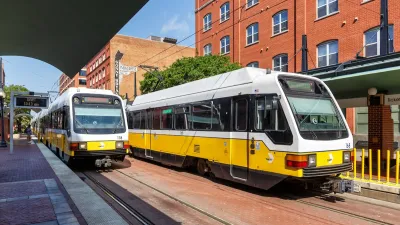No longer tied to minimum parking requirements, housing developers are starting to shift to more walkable, transit-oriented projects.

Developments designed to discourage private car ownership are being built in some traditionally car-oriented parts of the country, serving as potential models for future car-light development.
According to an article by Patrick Sisson in Bloomberg CityLab, “A confluence of trends has made such projects both more financially viable and marketable — especially in the South and Sun Belt, where zoning rules are often more permissive but car dependency and the urge to sprawl can be just as powerful.”
With parking spots costing tens of thousands of dollars apiece to build, developers are finding it more attractive to build communities without sprawling parking lots. “The Terner Center for Housing Innovation at the University of California at Berkeley estimated that parking adds up to $36,000 per unit of new housing built in the state.”
Sisson describes developments in Charlotte, Tempe, and Houston that are drastically reducing parking and creating walkable and transit-oriented spaces. A proposed 17-acre development in east Houston by Concept Neighborhoods with little on-site only became possible after the city relaxed parking requirements in some parts of town, letting developers decide how much parking to build. In Miami, a new high-rise development next to the Douglas Road Metrorail station touts public amenities and ground-floor retail.
FULL STORY: Car-Free Living Takes Off in Car-Centric Cities

Alabama: Trump Terminates Settlements for Black Communities Harmed By Raw Sewage
Trump deemed the landmark civil rights agreement “illegal DEI and environmental justice policy.”

Study: Maui’s Plan to Convert Vacation Rentals to Long-Term Housing Could Cause Nearly $1 Billion Economic Loss
The plan would reduce visitor accommodation by 25% resulting in 1,900 jobs lost.

Planetizen Federal Action Tracker
A weekly monitor of how Trump’s orders and actions are impacting planners and planning in America.

Waymo Gets Permission to Map SF’s Market Street
If allowed to operate on the traffic-restricted street, Waymo’s autonomous taxis would have a leg up over ride-hailing competitors — and counter the city’s efforts to grow bike and pedestrian on the thoroughfare.

Parklet Symposium Highlights the Success of Shared Spaces
Parklets got a boost during the Covid-19 pandemic, when the concept was translated to outdoor dining programs that offered restaurants a lifeline during the shutdown.

Federal Homelessness Agency Places Entire Staff on Leave
The U.S. Interagency Council on Homelessness is the only federal agency dedicated to preventing and ending homelessness.
Urban Design for Planners 1: Software Tools
This six-course series explores essential urban design concepts using open source software and equips planners with the tools they need to participate fully in the urban design process.
Planning for Universal Design
Learn the tools for implementing Universal Design in planning regulations.
Caltrans
Smith Gee Studio
Institute for Housing and Urban Development Studies (IHS)
City of Grandview
Harvard GSD Executive Education
Toledo-Lucas County Plan Commissions
Salt Lake City
NYU Wagner Graduate School of Public Service





























